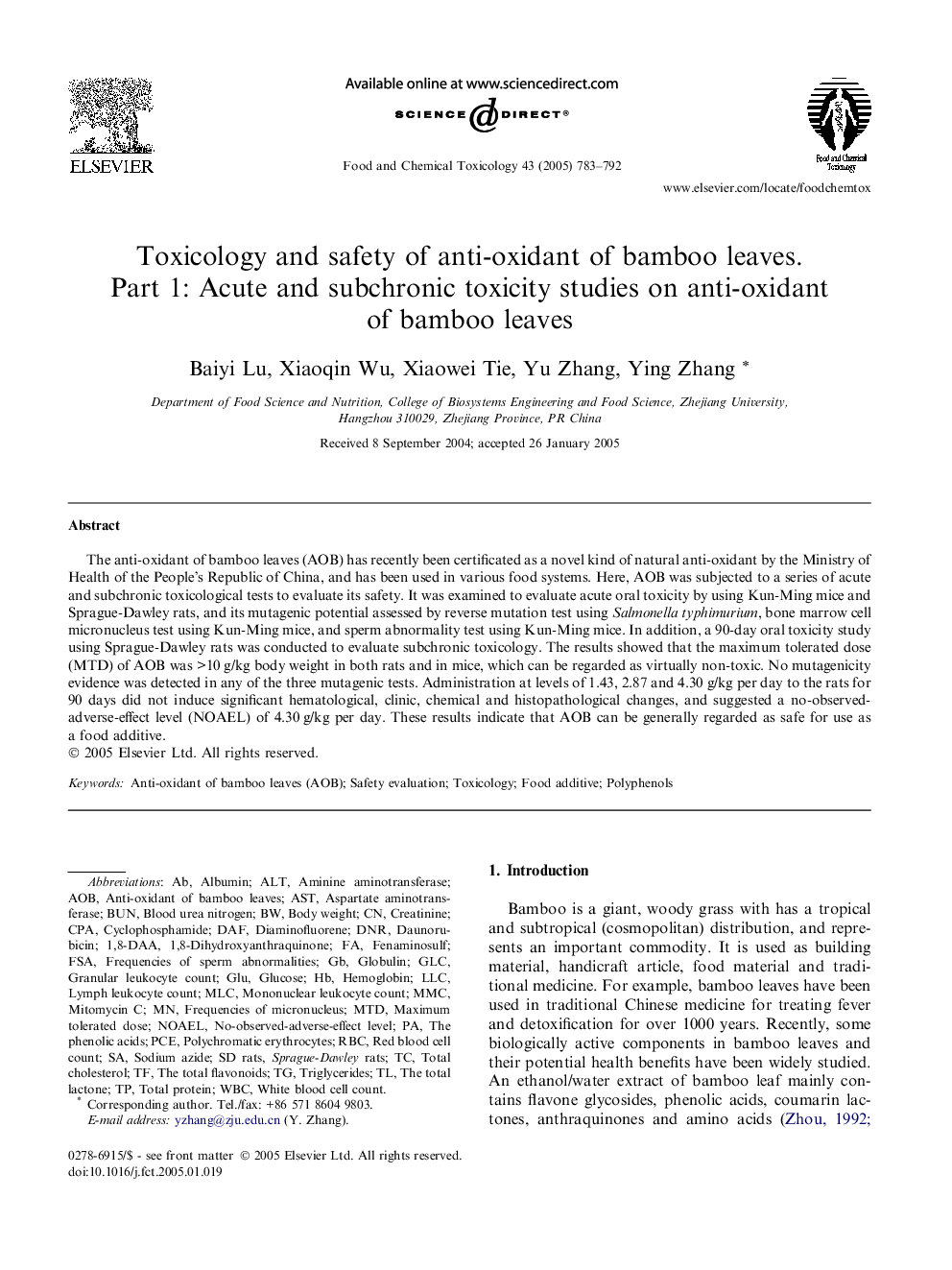| کد مقاله | کد نشریه | سال انتشار | مقاله انگلیسی | نسخه تمام متن |
|---|---|---|---|---|
| 9030664 | 1130932 | 2005 | 10 صفحه PDF | دانلود رایگان |
عنوان انگلیسی مقاله ISI
Toxicology and safety of anti-oxidant of bamboo leaves. Part 1: Acute and subchronic toxicity studies on anti-oxidant of bamboo leaves
دانلود مقاله + سفارش ترجمه
دانلود مقاله ISI انگلیسی
رایگان برای ایرانیان
کلمات کلیدی
PCE, polychromatic erythrocytesRBC, red blood cell countbw, body weight - bw، وزن بدنCPA, cyclophosphamide - CPA، سیکلوفسفامیدDNR, daunorubicin - DNR، daunorubicinGLU, glucose - GLU، گلوکزHb, hemoglobin - Hb، هموگلوبینMMC, mitomycin C - MMC، میتومایسین CMTD, maximum tolerated dose - MTD، حداکثر دوز قابل تحملNOAEL, no-observed-adverse-effect level - NOAEL، سطح بدون عوارض جانبی مشاهده نشده استTG, triglycerides - TG، تری گلیسریدTP, total protein - TP، پروتئین کلWBC, white blood cell count - WBC، شمارش گلبول های سفیدAST, aspartate aminotransferase - آزمایش آسپارتات آمینوترانسفرازSafety evaluation - ارزیابی ایمنیToxicology - سمشناسیFood additive - مکمل غذاییBUN, blood urea nitrogen - نیتروژن اوره خونPolyphenols - پلیفنلهاTC, total cholesterol - کلسترول تام، کلسترول کلی، کلسترول توتال
موضوعات مرتبط
علوم زیستی و بیوفناوری
علوم کشاورزی و بیولوژیک
دانش تغذیه
پیش نمایش صفحه اول مقاله

چکیده انگلیسی
The anti-oxidant of bamboo leaves (AOB) has recently been certificated as a novel kind of natural anti-oxidant by the Ministry of Health of the People's Republic of China, and has been used in various food systems. Here, AOB was subjected to a series of acute and subchronic toxicological tests to evaluate its safety. It was examined to evaluate acute oral toxicity by using Kun-Ming mice and Sprague-Dawley rats, and its mutagenic potential assessed by reverse mutation test using Salmonella typhimurium, bone marrow cell micronucleus test using Kun-Ming mice, and sperm abnormality test using Kun-Ming mice. In addition, a 90-day oral toxicity study using Sprague-Dawley rats was conducted to evaluate subchronic toxicology. The results showed that the maximum tolerated dose (MTD) of AOB was >10Â g/kg body weight in both rats and in mice, which can be regarded as virtually non-toxic. No mutagenicity evidence was detected in any of the three mutagenic tests. Administration at levels of 1.43, 2.87 and 4.30Â g/kg per day to the rats for 90 days did not induce significant hematological, clinic, chemical and histopathological changes, and suggested a no-observed-adverse-effect level (NOAEL) of 4.30Â g/kg per day. These results indicate that AOB can be generally regarded as safe for use as a food additive.
ناشر
Database: Elsevier - ScienceDirect (ساینس دایرکت)
Journal: Food and Chemical Toxicology - Volume 43, Issue 5, May 2005, Pages 783-792
Journal: Food and Chemical Toxicology - Volume 43, Issue 5, May 2005, Pages 783-792
نویسندگان
Baiyi Lu, Xiaoqin Wu, Xiaowei Tie, Yu Zhang, Ying Zhang,